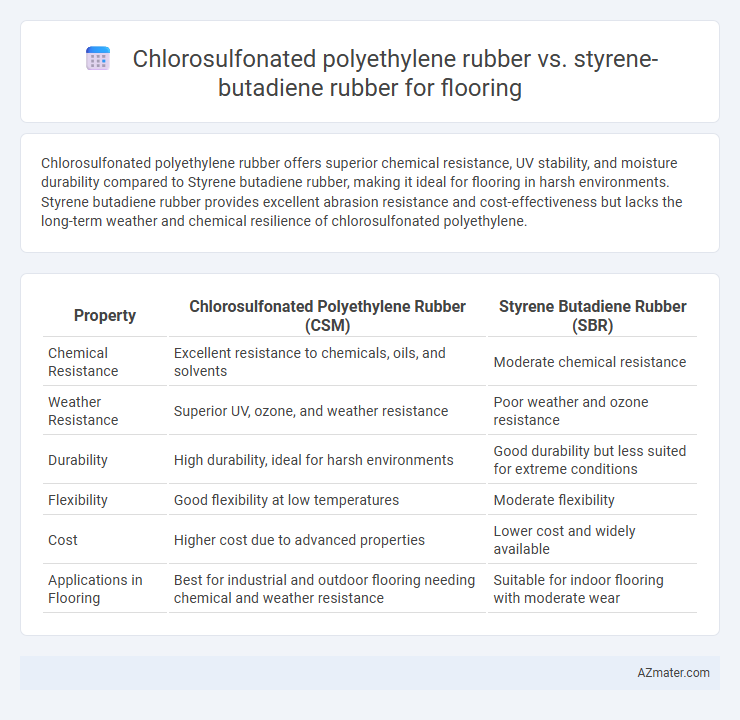Chlorosulfonated polyethylene rubber offers superior chemical resistance, UV stability, and moisture durability compared to Styrene butadiene rubber, making it ideal for flooring in harsh environments. Styrene butadiene rubber provides excellent abrasion resistance and cost-effectiveness but lacks the long-term weather and chemical resilience of chlorosulfonated polyethylene.
Table of Comparison
| Property | Chlorosulfonated Polyethylene Rubber (CSM) | Styrene Butadiene Rubber (SBR) |
|---|---|---|
| Chemical Resistance | Excellent resistance to chemicals, oils, and solvents | Moderate chemical resistance |
| Weather Resistance | Superior UV, ozone, and weather resistance | Poor weather and ozone resistance |
| Durability | High durability, ideal for harsh environments | Good durability but less suited for extreme conditions |
| Flexibility | Good flexibility at low temperatures | Moderate flexibility |
| Cost | Higher cost due to advanced properties | Lower cost and widely available |
| Applications in Flooring | Best for industrial and outdoor flooring needing chemical and weather resistance | Suitable for indoor flooring with moderate wear |
Introduction to CSM and SBR for Flooring
Chlorosulfonated polyethylene (CSM) rubber offers superior chemical resistance, weatherability, and durability compared to styrene butadiene rubber (SBR), making it highly suitable for flooring applications in harsh environments. SBR provides good abrasion resistance and cost-effectiveness but lacks the enhanced weathering and oil resistance properties of CSM. Flooring materials utilizing CSM ensure longer service life and maintenance of physical properties under exposure to chemicals and UV radiation.
Key Chemical Properties: CSM vs SBR
Chlorosulfonated polyethylene (CSM) rubber exhibits superior chemical resistance, particularly against oils, ozone, and UV radiation, making it highly durable for flooring applications exposed to harsh environments. Styrene butadiene rubber (SBR) offers excellent abrasion resistance and flexibility but shows lower resistance to chemicals and ozone compared to CSM. The high chlorine content in CSM's polymer chain enhances its weatherability and flame retardancy, whereas SBR's unsaturated hydrocarbon backbone makes it more prone to oxidative degradation.
Mechanical Performance in Flooring Applications
Chlorosulfonated polyethylene (CSM) rubber exhibits superior mechanical performance in flooring applications due to its excellent abrasion resistance, enhanced tensile strength, and outstanding resistance to weathering and chemicals compared to styrene butadiene rubber (SBR). SBR offers good elasticity and initial strength but tends to degrade faster under harsh environmental conditions, reducing long-term durability for flooring use. The superior mechanical robustness and chemical stability of CSM make it ideal for high-traffic and industrial flooring environments requiring resilience and longevity.
Resistance to Heat and Chemicals
Chlorosulfonated polyethylene rubber (CSM) exhibits superior resistance to heat and chemical exposure compared to styrene butadiene rubber (SBR), making it ideal for flooring applications in harsh environments. CSM maintains structural integrity and performance at temperatures up to 130degC, while SBR typically degrades beyond 100degC. Chemical resistance to acids, alkalis, and solvents is significantly higher in CSM, ensuring longer durability and reduced maintenance in industrial or commercial flooring.
Durability and Lifespan in Flooring
Chlorosulfonated polyethylene (CSPE) rubber offers superior resistance to weathering, chemicals, and UV radiation, making it highly durable for flooring applications exposed to harsh environments. Styrene butadiene rubber (SBR), while cost-effective and providing good abrasion resistance, tends to degrade faster under prolonged exposure to sunlight and ozone, reducing its lifespan compared to CSPE. Flooring systems utilizing CSPE rubber typically achieve longer service life and maintain mechanical integrity better, especially in industrial or outdoor settings.
Water and Weather Resistance Comparison
Chlorosulfonated polyethylene (CSM) rubber exhibits superior water and weather resistance compared to Styrene butadiene rubber (SBR), making it ideal for outdoor and moisture-prone flooring applications. CSM's enhanced chlorine and sulfonyl groups confer excellent resistance to UV radiation, ozone, and chemical exposure, preventing degradation and maintaining durability over time. In contrast, SBR tends to absorb more water and shows reduced resistance to weathering, leading to faster deterioration in harsh environmental conditions.
Installation and Processing Differences
Chlorosulfonated polyethylene (CSPE) rubber offers superior chemical resistance and weather durability, making it ideal for flooring in harsh environments, while styrene butadiene rubber (SBR) provides excellent abrasion resistance suited for high-traffic areas. CSPE flooring requires specialized curing processes involving vulcanization with sulfur compounds, leading to longer installation times and the need for controlled temperature and humidity conditions. In contrast, SBR flooring benefits from faster, more straightforward processing with commonly used vulcanization agents, facilitating quicker installation and easier on-site adjustments.
Cost Analysis: CSM vs SBR Floors
Chlorosulfonated polyethylene (CSM) rubber flooring generally commands a higher initial cost compared to Styrene butadiene rubber (SBR) flooring due to its superior chemical resistance and durability. SBR flooring offers a more budget-friendly solution, with lower material expenses but may incur greater maintenance costs over time due to lower resistance to abrasion and chemicals. When conducting a cost analysis, factoring in lifecycle costs, including installation, maintenance, and replacement frequency, is crucial to determine the overall economic efficiency of CSM versus SBR flooring.
Typical Use Cases and Industry Preferences
Chlorosulfonated polyethylene (CSPE) rubber is favored in flooring applications requiring superior chemical resistance, UV stability, and weatherproofing, making it ideal for industrial and outdoor environments such as roofing and waterproof membranes. Styrene butadiene rubber (SBR) is commonly preferred in general-purpose flooring due to its excellent abrasion resistance, cost-effectiveness, and good mechanical properties, often utilized in indoor commercial and residential floors. Industry preferences lean towards CSPE for harsh environmental conditions and long-term durability, whereas SBR is chosen for wear resistance and budget-sensitive projects.
Choosing the Right Rubber for Flooring Needs
Chlorosulfonated polyethylene (CSM) rubber offers superior chemical resistance and weather durability compared to styrene butadiene rubber (SBR), making it ideal for outdoor flooring exposed to harsh environments. SBR excels in abrasion resistance and flexibility, providing excellent shock absorption for indoor flooring applications. Selecting between CSM and SBR depends on specific flooring requirements such as exposure conditions, durability, and mechanical performance.

Infographic: Chlorosulfonated polyethylene rubber vs Styrene butadiene rubber for Flooring
 azmater.com
azmater.com